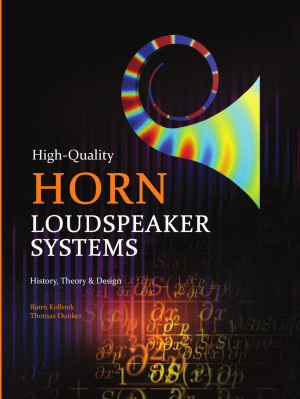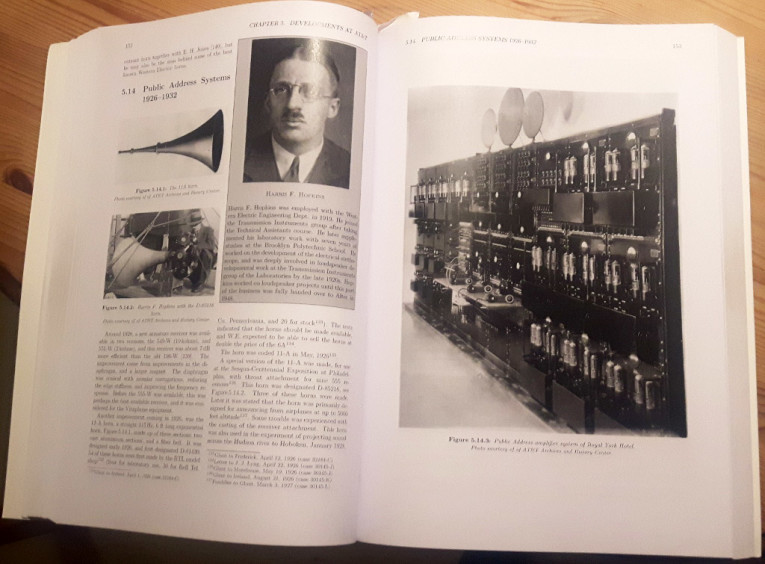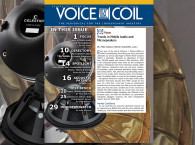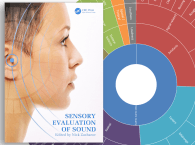 As the title of the book under review clearly states, this is a book about horn history, theory, and design. Development work and papers on horns and compression drivers are well covered in the trade magazines and technical journals. Nevertheless, this topic for the focus of a reference book is a good idea as it has not been addressed lately and has been superbly executed.
As the title of the book under review clearly states, this is a book about horn history, theory, and design. Development work and papers on horns and compression drivers are well covered in the trade magazines and technical journals. Nevertheless, this topic for the focus of a reference book is a good idea as it has not been addressed lately and has been superbly executed. Co-author Thomas Dunker referred to this book as the missing piece of his library. For speaker engineers, I think we can concur on behalf of all our colleagues. But if I need to be more precise, this is the finest reference work on horn loudspeakers possibly in the history of mankind. I am not worthy to review and judge this work, but only serve to carry the message of its existence to our readers.
Background Information
The authors are native Norwegians but thankfully for most of us they decided to use their second language, English. While they apologize for any shortcomings in their language skills, their work provides clean, concise, and well-written content resulting in a polished and professional resource book. As a scholarly reference, the table of contents and bibliographies after each chapter are finished off with a full index.
One of the authors, Bjørn Kolbrek, received his doctorate with his dissertation “Extensions to the Mode Matching Method for Horn Loudspeaker Simulation” in 2016. Kolbrek's interest in horn speakers originated in the late 1990s and he started working for Celestion in the UK right after finally earning his doctorate at the NTNU in Norway. Longtime audioXpress readers might remember Kolbrek’s “Introduction to Horn Theory Part 1 and Part 2” written back in March and April 2008. But even before this article, the authors collaborated on horn speaker research in 2004. At that time, both experts were looking for answers to some of the same questions and both had studied the theory of horn speakers for some time and collected a great deal of literature.
Thomas Dunker, the other author, is also a passionate audio experimenter and DIYer, and while horns have remained his avocation rather than vocation, he still has immersed himself in the subject for more than 25 years. The historical aspects found within the book were his main contribution, but Kolbrek also contributed to the history section.
The foreword is by Mark Dodd, which most us know as a longtime Celestion employee and head of research. The book reflects positively on the entire Celestion team and the brand itself. In recent years, some quite superb and innovative drivers have come from Celestion, so the knowledge gained from this study apparently has “rubbed off” on the product development team!
The Content
But let me push forward into the book itself. High Quality Horn Loudspeaker Systems is well beyond comprehensive, it is a truly exhaustive exploration of the field. With apologies to the religiously sensitive, and I say this with all respect — the title would be more accurate if it was The Bible of High Quality Horn Loudspeaker Systems. This tome is more than 1,000 pages, the first section is a history of electroacoustic transducers from the telephone receiver to movie sound and broadcast monitors onward. Each pioneering firm’s efforts are documented from Western Electric to AT&T, RCA, Vitavox, and many more.
Most of us know the story that arguably the first speaker was invented by Peter Laurits Jensen, living in Napa, CA. But the real story is that Jensen was not really a local. He was consulting in the area and was still very much Scandinavian (Danish). Aside from the formal history, the authors have distilled many of the “back stories” from the dusty basement archives of several institutions.
With the history out of the way, the book continues onto theory and design with a thorough exploration of horn loudspeakers up through today. While you could read every Audio Engineering Society (AES) paper in its E-library, it is obvious Kolbrek and Dunker beat you to it. Out of curiosity, I picked a couple of obscure topics to see if all the trivia was sorted and covered. Within every nook and cranny I looked, I found the authors had long ago signed the guestbook. In a few instances where I thought something might have been left out, I stumbled onto well-researched coverage later on in the book. Of course, as soon as anything is published, on-going developments will continue and I am sure their second edition will be well-received in a couple of years.
Since the pressure was on to publish a review of this book right away, I have yet to completely read the entire 1,070 pages. I did dig deeper on a few sensitive topics such as Constant Directivity. From time to time everyone (and every industry), goes off the rails and chases stray balls. I always felt the pro-sound engineering (and marketing) community’s foray into constant beamwidth as a main performance criteria at the expense of sound quality (transient response and resonance) in the 1970s was a fool’s errand. So I was quite curious how the book would treat what for me was the dark ages of horn design — the attempt at constant directivity (CD) at all cost for a number of years — with only a few speaker engineers not pursuing that avenue of development.
Those early efforts resulted in the terrible sounding horns of the 1970s (e.g., the Electro-Voice White Horns, the Altec MantaRay, and a couple of Community CD horns) — they all had throat aspect ratios that heavily compromised clarity in order to gain a wider pattern above 8 KHz. The application of these horns in the cinema resulted in unpleasant and fatiguing dialog. Yet, the mantra for constant directivity was mainly driven by the marketing departments. As expected, the authors’ frank comments about the nasty nasal shortcomings and astute insights on chasing pattern control at the top-end at the expense of acoustic aesthetics hit the nail on the head.
However, not all companies chased the constant directivity mandate, including the Meyer Sound products, some of the Yorkville Pulse series horns, some Beyma designs — these examples found ways to avoid the failings of these early CD designs. Yet, the same design engineers who developed most of the CD horns later went on to give us some very fine horns with extended bandwidth with fairly constant directivity. Don Keele’s bi-radial horn in 1980 managed to deliver both clean sound and good wideband directivity earning JBL renewed respect in studio monitors and the cinema market.
So many topics are addressed that are not commonly discussed, such as the serious compromises in sound quality that seemingly we all have come to accept. Throat distortion due to higher compression ratios are addressed within a number of sections. Lower compression ratios are a path to enabling horns speakers not to have “horn sound.” Some examples where top-end was intentionally sacrificed (or the driver was intended for three-way designs) such as the Community M4 and the CMR, some of Cliff Hendricksen’s work for Bose Professional such as the L1, the JBL 4” rapid flare throat mid-range compression drivers, and a number of Tannoy co-ax designs.

Similarly, the book also addresses the untidy issue of the expansion rate of the compression driver phase plug not optimally matching to the horn. Yes, it would be a better world if compression drivers were integrated designs as a super tweeter is designed.
Earl Geddes’ Oblate Spheroidal Waveguide horn is discussed along with how the theory of operation evolved. As a side note, it might be worth a look at the more recent article on this topic that was written by Dario Cinanni and published in the December issue of Voice Coil (audioXpress’ sister magazine).
Compression driver diaphragms from plastics — polyimide (Kapton)— to and PET (Mylar) are mentioned, along with a discussion of aluminum, titanium, and beryllium but magnesium alloys are not (or it is something I missed). With esoteric materials from beryllium, thin-ply carbon fiber diaphragms (TPCD) and other products now have the promise of being able to lower the compression ratio and not need that path (another pun, sorry) to peak up the highs.
While horn design is a mature field, there are still significant innovations that would have made the early pioneers cheer — from advanced magnetics materials and more recently E.J. Christensen’s air motion transformer (AMT) driver, improving on Oskar Heil’s AMT principle, while it is not covered in the book, the authors do touch upon Eugene (Gene) Czerwinski’s early work on AMT compression drivers at Cerwin-Vega.
Overall Impressions
I will be studying this book for a long time to come and apologize for barely scraping the surface. I am sure, as I continue to immerse myself in this work, it will inspire numerous articles. If your work or hobby has anything to do with horn loudspeakers, you have a duty to acquire High Quality Horn Loudspeaker Systems. The audio community owes the authors a thank you for this comprehensive resource. aX
This article was originally published in audioXpress, February 2020.
High Quality Horn Loudspeaker Systems
Authors: Bjørn Kolbrek and Thomas Dunker
Publisher: Kolbrek Elektroakustikk
First Edition: October 2019
ISBN-10: 152724542X
ISBN-13: 978-1527245426
Hardcover: 1,070 pages
Orders can be placed here: hornspeakersystems.info






